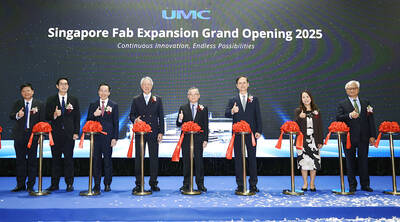Morgan Stanley Asia Ltd has retained its GDP growth forecast for Taiwan at 3.1 percent for this year, but lowered its forecast for next year from 2.9 percent to 2.7 percent because of economic uncertainty, it said in a report released on Monday.
The firm’s projections are lower than consensus growth forecasts of 3.6 percent for this year and 2.8 percent for next year, the report said.
Taiwan’s economy would grow 3.1 percent year-on-year in the first quarter and 3.9 percent in the second quarter, it said.

Photo: CNA
However, annual growth would slow in the second half of this year, rising 3.1 percent in the third quarter and 2.5 percent in the fourth quarter, it said.
Taiwan’s economy faces potential headwinds such as rising commodity prices, supply-side disruptions amid China’s “zero COVID-19” policy and declines in global demand, it said.
About 4.2 percent of Taiwan’s intermediate inputs and final use inputs come from China, the third highest among major Asian economies excluding Japan, the report said.
Taiwan’s computer, electronics and optical equipment sector, as well as the electrical and machinery sectors, are the most dependent on China for intermediate inputs, it said.
The effect of supply-chain disruptions in China is different from that of the chip supply shortage, Morgan Stanley said.
Upstream chip producers have somewhat benefited from the semiconductor shortage, while downstream firms suffered, it said.
By contrast, supply chain disruptions in China could affect both upstream and downstream firms in Asia, as China supplies more than 80 percent of global technology hardware, it said.
However, growth moderation in Taiwan would still be at a healthy level, as the nation is expected to benefit from the robust demand for technology products amid a long-term transition toward digitalization, automation and smart economies, the report said.
Besides, Taiwan’s shift from a “zero COVID-19” policy to a “new Taiwanese model” of coexisting with the virus, alongside high vaccination rates, should also help domestic demand to pick up in the second half of this year, it said.
Given higher commodity prices, Morgan Stanley expects the nation’s consumer price index to rise 3 percent this year and forecasts that the central bank would hike policy rates by 75 basis points by the end of this year.
The rates are likely to be raised to 1.625 percent at the end of this quarter, and further to 1.875 percent and 2.125 percent in the following two quarters, but might remain unchanged next year, it said.

‘SWASTICAR’: Tesla CEO Elon Musk’s close association with Donald Trump has prompted opponents to brand him a ‘Nazi’ and resulted in a dramatic drop in sales Demonstrators descended on Tesla Inc dealerships across the US, and in Europe and Canada on Saturday to protest company chief Elon Musk, who has amassed extraordinary power as a top adviser to US President Donald Trump. Waving signs with messages such as “Musk is stealing our money” and “Reclaim our country,” the protests largely took place peacefully following fiery episodes of vandalism on Tesla vehicles, dealerships and other facilities in recent weeks that US officials have denounced as terrorism. Hundreds rallied on Saturday outside the Tesla dealership in Manhattan. Some blasted Musk, the world’s richest man, while others demanded the shuttering of his

Taiwan’s official purchasing managers’ index (PMI) last month rose 0.2 percentage points to 54.2, in a second consecutive month of expansion, thanks to front-loading demand intended to avoid potential US tariff hikes, the Chung-Hua Institution for Economic Research (CIER, 中華經濟研究院) said yesterday. While short-term demand appeared robust, uncertainties rose due to US President Donald Trump’s unpredictable trade policy, CIER president Lien Hsien-ming (連賢明) told a news conference in Taipei. Taiwan’s economy this year would be characterized by high-level fluctuations and the volatility would be wilder than most expect, Lien said Demand for electronics, particularly semiconductors, continues to benefit from US technology giants’ effort

ADVERSARIES: The new list includes 11 entities in China and one in Taiwan, which is a local branch of Chinese cloud computing firm Inspur Group The US added dozens of entities to a trade blacklist on Tuesday, the US Department of Commerce said, in part to disrupt Beijing’s artificial intelligence (AI) and advanced computing capabilities. The action affects 80 entities from countries including China, the United Arab Emirates and Iran, with the commerce department citing their “activities contrary to US national security and foreign policy.” Those added to the “entity list” are restricted from obtaining US items and technologies without government authorization. “We will not allow adversaries to exploit American technology to bolster their own militaries and threaten American lives,” US Secretary of Commerce Howard Lutnick said. The entities

TIGHT-LIPPED: UMC said it had no merger plans at the moment, after Nikkei Asia reported that the firm and GlobalFoundries were considering restarting merger talks United Microelectronics Corp (UMC, 聯電), the world’s No. 4 contract chipmaker, yesterday launched a new US$5 billion 12-inch chip factory in Singapore as part of its latest effort to diversify its manufacturing footprint amid growing geopolitical risks. The new factory, adjacent to UMC’s existing Singapore fab in the Pasir Res Wafer Fab Park, is scheduled to enter volume production next year, utilizing mature 22-nanometer and 28-nanometer process technologies, UMC said in a statement. The company plans to invest US$5 billion during the first phase of the new fab, which would have an installed capacity of 30,000 12-inch wafers per month, it said. The